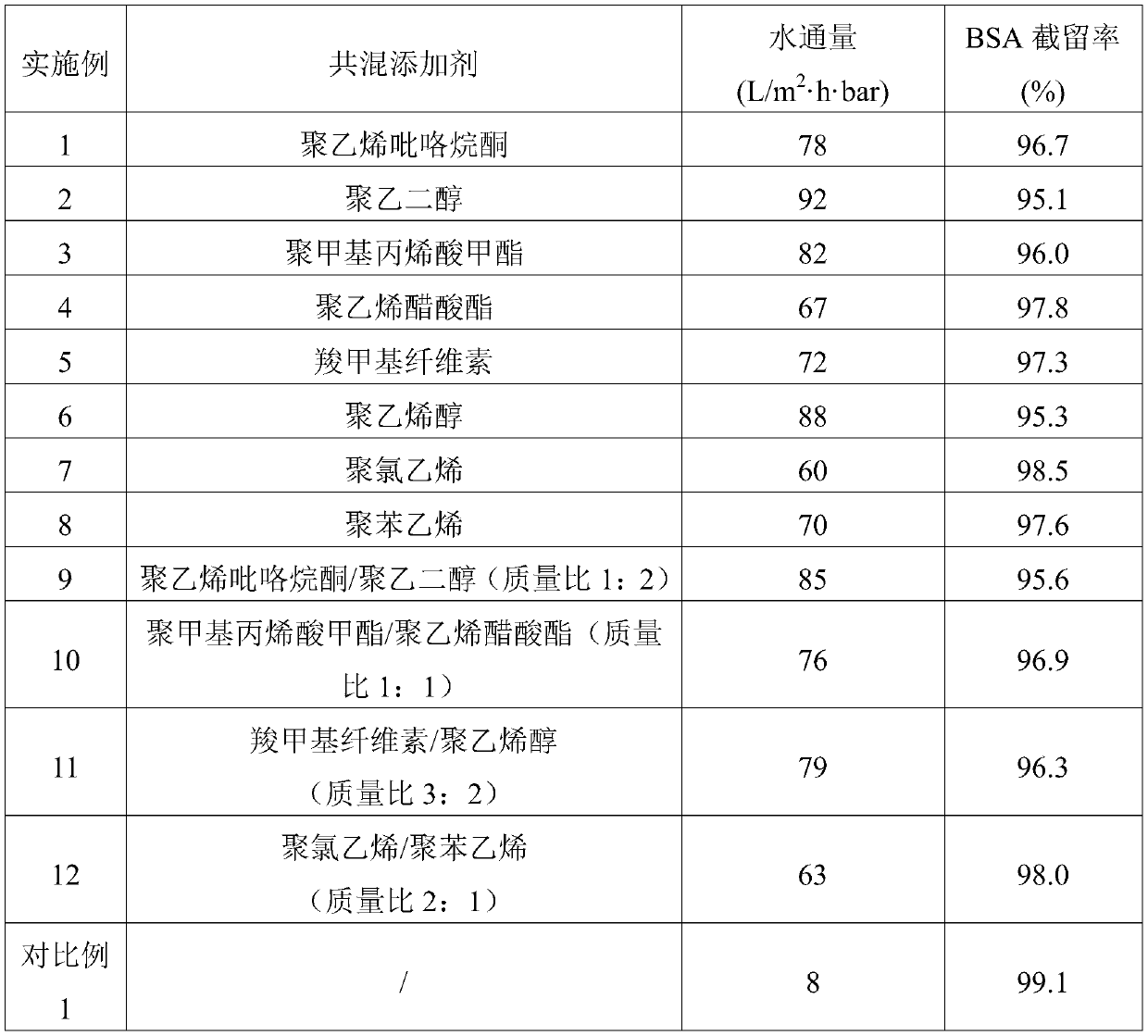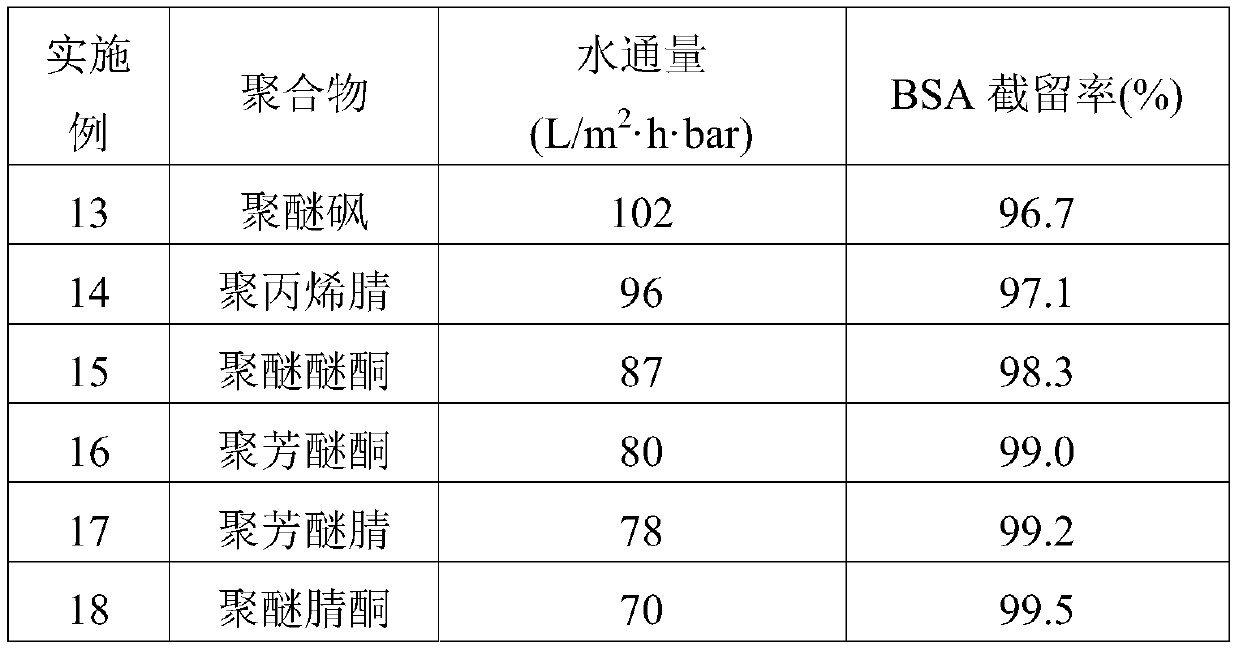Preparation method of high-permeability thermal crosslinking membrane
A high-permeability, thermal cross-linking technology, applied in the field of membrane separation technology and new materials, can solve the problems of membrane permeability reduction, pore structure fusion, etc., and achieve the effects of improving permeability, easy amplification, and wide adjustment range
- Summary
- Abstract
- Description
- Claims
- Application Information
AI Technical Summary
Benefits of technology
Problems solved by technology
Method used
Image
Examples
Embodiment 1
[0021] Using polysulfone as the polymer, polyvinylpyrrolidone as the blending additive, and N,N-dimethylformamide as the organic solvent, after mixing according to the mass ratio of 10:1:89, stir at 900rpm at 100°C for 2h The casting solution is obtained, and the casting solution is scraped on the substrate to form a nascent film, and then immersed in a pure water gel bath at room temperature for phase inversion and solvent exchange for 12 hours to prepare a polysulfone asymmetric membrane. Dry the prepared asymmetric membrane at 40°C for 36h, place the dried membrane in a muffle furnace at a rate of 30°C / min, raise the temperature to 120°C, keep the temperature constant for 60h, and obtain a polysulfone-based heat exchange membrane after cooling down. Connected ultrafiltration membrane. The ultrafiltration performance of the membrane at a test pressure of 0.1 MPa is shown in Table 1.
Embodiment 2-12
[0025] According to the experimental method of embodiment 1, the difference from embodiment 1 is that polyethylene glycol, polymethyl methacrylate, polyvinyl acetate, carboxymethyl cellulose, polyvinyl alcohol, polyvinyl chloride, polystyrene Ethylene, polyvinylpyrrolidone / polyethylene glycol (mass ratio 1:2), polymethyl methacrylate / polyvinyl acetate (mass ratio 1:1), carboxymethyl cellulose / polyvinyl alcohol (mass ratio 3 : 2), polyvinyl chloride / polystyrene (mass ratio 2: 1) is a blending additive to prepare a casting solution. The ultrafiltration performance of the prepared polysulfone-based thermally cross-linked ultrafiltration membrane at a test pressure of 0.1 MPa is shown in Table 1.
[0026] Table 1
[0027]
Embodiment 13-18
[0029] Polyethersulfone, polyacrylonitrile, polyether ether ketone, polyarylether ketone, polyarylether nitrile, polyether nitrile ketone as polymer, polyvinylpyrrolidone as blending additive, N,N-dimethylacetamide as Organic solvents, mixed according to the mass ratio of 20:20:60, stirred at 20°C for 24 hours at a speed of 300rpm to obtain a casting solution, scraped the casting solution on the substrate to form a primary film, and then immersed in a pure water gel bath at room temperature Phase inversion and solvent exchange were performed for 12 hours to produce an asymmetric membrane. The prepared asymmetric membrane was dried at 30°C for 48h, and the dried membrane was placed in a muffle furnace at a heating rate of 0.1°C / min to 300°C, kept at a constant temperature for 20h, and then thermally crosslinked membrane was obtained after cooling down. The ultrafiltration performance of the prepared thermally crosslinked ultrafiltration membrane at a test pressure of 0.1 MPa is...
PUM
 Login to View More
Login to View More Abstract
Description
Claims
Application Information
 Login to View More
Login to View More - R&D
- Intellectual Property
- Life Sciences
- Materials
- Tech Scout
- Unparalleled Data Quality
- Higher Quality Content
- 60% Fewer Hallucinations
Browse by: Latest US Patents, China's latest patents, Technical Efficacy Thesaurus, Application Domain, Technology Topic, Popular Technical Reports.
© 2025 PatSnap. All rights reserved.Legal|Privacy policy|Modern Slavery Act Transparency Statement|Sitemap|About US| Contact US: help@patsnap.com



